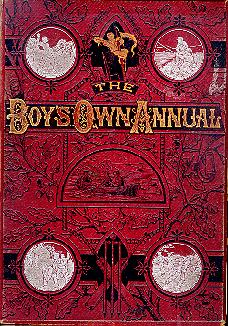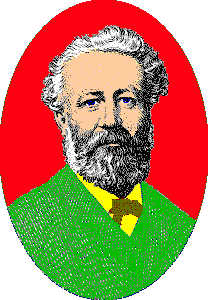|
Boy's Own Papers / Boy's Own Annual

1879, Vol 2, Boys' Own Annual
The Boy's Own Papers, was a weekly magazine for boys, founded
in 1879 and published by the Religious Tract Society. It ran until 1967, reached
a circulation around 250,000 and published adventure stories, often with
imperialist themes, as well as essays, letters, puzzles, and competitions.
Numerous stories by Jules Verne were published in serial form in
this paper, and many times, these serial forms of a Jules Verne book pre-date
the First English Edition of the book.
After a years worth of the serial was published, it was bound into
an "Annual". All parts for a serial (at least those by Verne, were complete
in that 1 volume)
Note: There was also an American Publication names Boy's Own,
published by Charles F. Richards, Boston Mass. This weekly started on Oct
11, 1873 and ran until about December, 1876. Jules Verne's Mysterious Island
was serialized in this publication from December 5, 1974 through March 20,
1875.
(this information on Boy's Own, was researched
by Brian Kutzera, North American Jules Verne Society Inc., and was presented
at the annual meeting in Hillsborough, North Carolina, May 19, 2001)
Brian also noted that Boy's Own Paper was also printed in
Toronto by the publisher W. Warwick and Sons.
The Papers are actually identical to the British Editions, except they have
a 4 page "cover", which is dated 1 month later than the contents, and which
contains ads for Toronto businesses. Examples of these "reprints" have been
noted for Aug 1884 and Aug 1885. It might therefore be possible to find examples
of these with Verne stories! (Once again, Thank you to Brian Kutzera for
this research)
The following article was copied from the Collector C@fe website
(www.collectorcafe.com)
The Boys' Own Paper
By John Crawford
Article address: http://www.collectorcafe.com/article_archive.asp?article=190&id=1297
Sold for just a penny a week, the Boys’ Own Paper was packed
with tales of derring-do, as well as advice that ranged from hobbies to cultivating
a moustache. Founded in 1879 and edited by the imaginative G.A. Hutchinson,
it was published by the Religious Tract Society. Hutchinson edited the paper
through its formative years and died at work in 1913. His years were characterised
by an underlying Christian morality and a need to encompass boys of all backgrounds
in the readership. Sport was always high on the agenda, with articles written
by such names as W.G. Grace and Jack Hobbs. The care of pets, school stories
and adventure, both fact and fiction, filled the columns. The colour plates
were astonishingly well printed for such a cheap paper, with artists of the
calibre of Stanley Wood and Frank Brangwyn providing some of the artwork.
The plates showed scenes of big game hunting, railway engines or even flags
of the world and were often removed to decorate walls or scrapbooks, a collector’s
loss but another indication of the popularity of the paper, which was even
read in the trenches in the First World War.
Though not first in the field of boys’ publications, the B.O.P.
had a more lasting influence on people of all classes and in middle age,
many began collecting from nostalgia for the days when manly virtues were
a guiding force in boyhood. Writers such as R.M. Ballantyne, Jules Verne and
Talbot Reed Baines, of “The Fifth Form at St. Dominic’s” fame, supplied exciting
reading, where virtue always triumphed, no matter how daunting the odds but
there was also an element of good clean fun to keep the readers, some as
old as eighteen, happy. By the 1890s, poorer boys were gradually sidelined,
with more concentration on public and grammar school interests. Photographs
of Rugby teams, heroes of the University Boat Race and headmasters of the
great schools were supplanting the useful advice to factory boys.
In 1914, the paper became a monthly and by 1918 the price
had risen to 1/6d, where it remained until the Second World War. The paper
kept up with the times, with advice on how to make wireless sets, mine laying
and gun making. The new monthly necessitated a change of form, with two columns
instead of three to each page. The mixture of articles on winter sports, flying,
motorcycling and adventure continued to attract readers in the 1920s and
30s. In 1939 it was taken over by Lutterworth Press. A depressing decade
of decline followed, as the paper became smaller. An attempt to revive its
fortunes was made when it was taken over by Purnell’s in 1963 and doubled
in size: this failed to halt the decline and the final edition was published
in 1967 with volume 89.
The impressive bound annuals are the simplest way for collectors
to assemble chronological sets.
Article address: http://www.collectorcafe.com/article_archive.asp?article=190&id=1297
|
|





